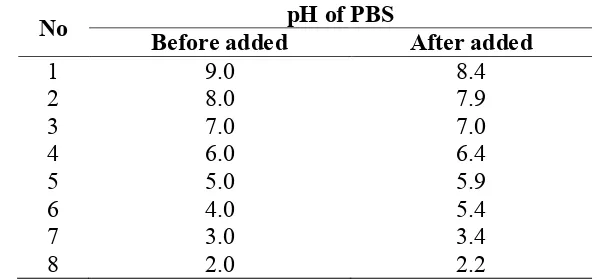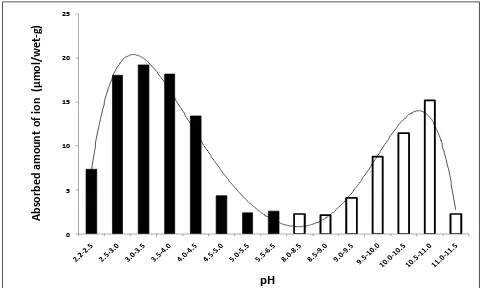The journal homepage www.jpacr.ub.ac.id p-ISSN : 2302 – 4690 | e-ISSN : 2541 – 0733
Electric Charge Characteristics of Biofilms Formed on Various
Surfaces
Andi Kurniawan12* and Yasuaki Fukuda3
1
Department of Aquatic Resources Management, Brawijaya University, Indonesia
2
Coastal and Marine Research Centre, Brawijaya University, Indonesia
3
College of Life Sciences, Ritsumeikan University, Japan
*
Corresponding email: [email protected]
Received 20 May 2016; Revised 7 June 2016; Accepted 27 June 2016
ABSTRACT
Biofilm is predominant habitats of microbes in aquatic environments. Biofilm forms when microbes attach on surfaces and produce extracellular polymeric substances. Biofilm matrix has been showed to have high sorption capacity to accumulate various ions including nutrient ions. The main driving force of the accumulation of the ions is supposed to be an electrostatic interaction between the nutrient and the biofilm polymer. Hence, the understanding of electric charge properties of biofilm polymer is critically important to understand the accumulation process. The present study aimed to investigate the characteristics of electric charge properties of biofilm polymer from biofilms formed on various surfaces (stone, wood, glass bottle, Teflon, rubber, and stainless steel). The electric charge properties of biofilm polymers were investigated by measuring the electrophoretic mobility of the biofilms in various pHs (range from pH 2 to pH 9) and titrated HCl and NaOH aqueous solution to the biofilm suspension. The results indicated that biofilm matrices seemed to have both negatively and positively charged sites as a result of ionization of functional groups existed in biofilm polymers. According to the results of this study, there is a universal characteristic of electric charge properties of biofilms regardless of the kind of substrate.
Key word: biofilm matrix, biofilm polymers, electric charge properties, aquatic environment
INTRODUCTION
A predominant habitat of microbes in aquatic environments is biofilms. Biofilm is generally defined as an aggregate of microbes that formed on the surfaces [1-4]. These microbial aggregates have been found almost in all aquatic ecosystems from fresh water until ocean. In the ecosystems, microbial biofilms have various important functions such nutrient cycling [5] and purification of pollutants [6].
The main driving force for ion adsorption to the biofilm matrix is a physicochemical interaction between the charged sites in the biofilm polymer and the ions in the surrounding water [11]. However, although the electric charge characteristics of biofilm polymer are important not only to accumulate ions inside the biofilms, but also to stabilize flexibly the aquatic ecosystem concerning ion concentrations [12], the study concerning the electric charge properties of biofilm polymers formed on various surfaces in aquatic environments have rarely been conducted. Thus, the present study investigated the electric charge characteristics of polymers of biofilm formed on various substrates (stone, wood, glass bottle, Teflon, rubber and stainless steel) in the lake ecosystem.
EXPERIMENT
Chemicals and instrumentation
Chemicals used for this research were NaCl (Wako), Na2HPO4∙12H2O (Wako), HCl
aqueous solution (Wako), NaOH aqueous solution (Wako) and Ethanol 95% (Wako). Meanwhile some main instruments operated in this present study were High Speed Refrigerated Centrifuge (Tomy MX-305 High Speed Refrigerated Micro Centrifuge, Tomy Seiko CO. LTD., Japan), Vortex (Vortex Genie 2, M&S Instruments, Inc., Osaka, Japan), pH meter (Mettler Toledo S220K SevenCompact pH/Ion Meter, Mettler Toledo International Inc., USA), Ultrasound machine (2510J-MT, Yamato Scientific, Tokyo, Japan; 42 kHz, 125 W), Automated Titrator (DL50, Mettler, Toledo, OH, USA and ZETASIZER Nano-Z (Malvern Instruments, Ltd., Worcestershire, England).
Biofilm sample preparation
Biofilms used in this study were biofilms formed on the surface of stone, wood, glass bottle, Teflon, rubber and stainless steel. More than 2 months before the sampling date, the substrates were placed in the Akanoiwan shore of Lake Biwa Japan at a depth of ca. 70 cm in order to let biofilm form on the surface of those substrates. The sampling was conducted in the middle of April 2013. The substrates covered by biofilms were collected and brought back to the laboratory in a plastic container filled with lake water from the same site. The temperature of the container was maintained at 4°C. The biofilms were removed from the surfaces of the substrates with a sterilized toothbrush and then suspended in distilled water. The suspensions were centrifuged (8,000 × g at 4°C for 10 min), and biofilm pellets were obtained. All the pellets were stored at -40°C until their use in the experiments.
Electrophoretic mobility measurement
Nano-Z (Malvern Instruments, Ltd., Worcestershire, England) in PBS varying in pH values from 2.0 to 9.0. The pH of the buffer was adjusted with 20 mM HCl or NaOH aqueous solution to maintain a constant ionic strength (10 mM).
Potentiometric titration
Part of the biofilm pellet (from biofilm formed on the stones) was placed in a plastic cup (100 mL), and distilled water was added to give a total weight of 40 g. Then, 10 mM of HCl or 10 mM of NaOH aqueous solution was titrated onto the samples using an automatic titration machine (DL50, Mettler, Toledo, OH, USA). The pH changes were recorded and analyzed. Intact lake water samples (40 mL) were also subjected to titration. The uptake capacity of proton/hydroxide ion of biofilm or lake water was calculated based on equation reported by Kurniawan et al. [11] as described below:
w same amount of HCl or NaOH solution was added. The term v represents the sample volume (L), and w is the wet weight of the biofilm (wet-g) or the weight of lake water (g). When NaOH solution was added, the uptake capacity of hydroxide ions (OH-) per unit weight of biofilm or lake water, C(OH-) was obtained by a similar equation as follows:
w The other terms are the same as above.
RESULT AND DISCUSSION
Electric charge of the biofilm at various pH values
The electrophoretic mobility (EPM) values of biofilm polymers were measured (Fig. 1). The result was used to analysis the surface charge distribution of biofilm polymer and estimates the functional groups in biofilm polymer.
Figure 1. Changes in the electrophoretic mobility (EPM) of the biofilm polymers with pH. EPM was measured under various pH conditions. Bars represent the standard error.
The biofilm exhibited a positive EPM at pH 2, indicating the existence of positively charged functional groups, thought to be amino groups, in the biofilm polymer. The charged state of the amine depends on the pH of the solution. When the pH of the solution is below the pKa, the group will be in its protonated state. Hence, amines have pKa's around 11, and thus, at pHs lower than around 11, amines will be protonated (i.e., NH3+). The presence of
amino groups in the biofilm polymers has been reported also by previous studies [8,13-15]. The pH of the buffer solution used in the EPM measurement increased after the biofilm samples were added (Table 1), e.g., buffer solutions with pH 4.0 and 5.0 shifted to 5.4 and 5.9, respectively. This indicated a decrease in the concentration of protons by an addition of the biofilm samples. Protons seem to de-ionize acidic functional groups such as the carboxylic group, which is the most probable acidic functional group in the biofilm polymer.
Table 1. pHs of the solution before and after added biofilm polymers.
No pH of PBS
Before added After added
1 9.0 8.4
2 8.0 7.9
3 7.0 7.0
4 6.0 6.4
5 5.0 5.9
6 4.0 5.4
7 3.0 3.4
8 2.0 2.2
Potentiometric titration of the biofilm
Potentiometric titrations of the biofilm and lake water to identify the functional groups
-3 -2 -1 0 1
0 2 4 6 8 10
E
P
M
(
×
10
-8m 2v -1s
-1) pH
Figure 2. Potentiometric titration of the biofilm, lake water, and distilled water.
The Potentiometric titrations curve of biofilm was different from that of distilled water (as a background solution). This clearly reveals the presence of ionizable functional groups associated with biofilm polymer. The Potentiometric titrations curve of lake water showed higher/lower pH in the addition of HCl (0.03-1.35 mL) or NaOH (0.03-1.08 mL) than distilled water. This result indicates the existence of some small particles carrying ionizable functional groups in the lake water.
The maximum difference of pHs in the acid-base titration curve between biofilm and distilled water were at around pH 4 for HCl addition and at around pH 11 for NaOH addition. Similarly, the maximum uptake capacity of biofilm appeared at pH 3-4 for proton adsorption and pH 10-11 for hydroxyl ion adsorption. The maximum adsorption of proton and hydroxide ion by biofilm were about 19 µmol/wet-g for proton and 15 µmol/wet-g for hydroxide ion (Fig. 4). It seems at around pH 4 and pH 11 there are some functional groups in biofilm polymer having maximum ability to adsorb proton and hydroxide ion respectively. The peak at pH 4 may indicate the existence of carboxyl groups (pKa = ca. 4), and that at pH 11 the existence of amino groups (pKa = ca.11).
Figure 4. The adsorbed amount of H+ (black column) or OH- (white column) per unit weight of biofilm calculated using equations 1 and 2 described in EXPERIMENT section.
CONCLUSION
this study, biofilms show the universal characteristic of electric charge properties regardless the kind of substrates. The universal characteristics are needed to be clarified more by investigating the charge properties of the polymer of biofilm matrix formed in more various conditions such different regions (tropical, subtropical, pole) or different season (dry, rainy, summer, winter, spring, autumn).
ACKNOWLEDGMENT
This study is part of research project supervised by Prof. Hisao Morisaki from Graduate School of Life Sciences, Ritsumeikan University. The authors are grateful to Dr. Yuki Tsuchiya from Faculty of Life Science, Ritsumeikan University for data analysis and discussion.
REFERENCES
[1] Costerton, J. W., Z. Lewandowski, D. E. Caldwell, D. R. Korber, and H. M. Lappin-Scott. Annu. Rev. Microbiol., 1995, 49, 711–745.
[2] Tsuchiya, Y., M. Ikenaga, A. Kurniawan, A. Hiraki, T. Arakawa, R. Kusakabe, and H. Morisaki. Microbes Environ. 2009, 24 (1), 43–51.
[3] Gadd, G. M., J. Chem. Technol. Biotechnol., 2009, 4, 13–28.
[4] Hiraki, A., Y. Tsuchiya, Y. Fukuda, T. Yamamoto, A. Kurniawan, and H. Morisaki.
Microbes Environ., 2009, 24 (3), 265–272.
[5] Sabater, S., H. Guasch, A. Romani, I. Munoz, Hydrobiologia, 2002, 469, 149-156. [6] Kurniawan, A., and T. Yamamoto. Procedia Environ. Sci. 2013, 17, 179-187.
[7] Kurniawan, A., Guntur, A. Hiraki, Y. Fukuda, T. Yamamoto, Procedia Environ. Sci.,
2015, 28, 252-257.
[8] Flemming, H. C., and J. Wingender, Nat. Rev. Microbiol. 2010, 8, 623-633.
[9] Costerton, J. W., R. T. Irvin and K. J. Cheng, Annu. Rev. Microbiol., 1981, 35, 299-324. [10] Keevil, C. W., A. Godfree, D. Holt, and C. Dow, Biofilms in the aquatic environment,
1999, The Royal Society of Chemistry, Cambridge.
[11] Kurniawan A., T. Yamamoto, Y. Tsuchiya, H. Morisaki. Microbes Environ. 2012, 27 (4), 399-406.
[12] Kurniawan A., Y. Tsuchiya, S. Eda, H. Morisaki, Colloids and Surfaces B: Biointerfaces., 2015, 136, 22-26.
[13] Kurniawan, A., and Y. Fukuda, 2015. Microbiol Indones., 2015. 9(3), 106-112.
[14] Nevius, B. A., Y. P. Chen, J. L. Ferry, A. W. Decho. Ecotoxicology, 2012, 21(8), 2205-2213.

